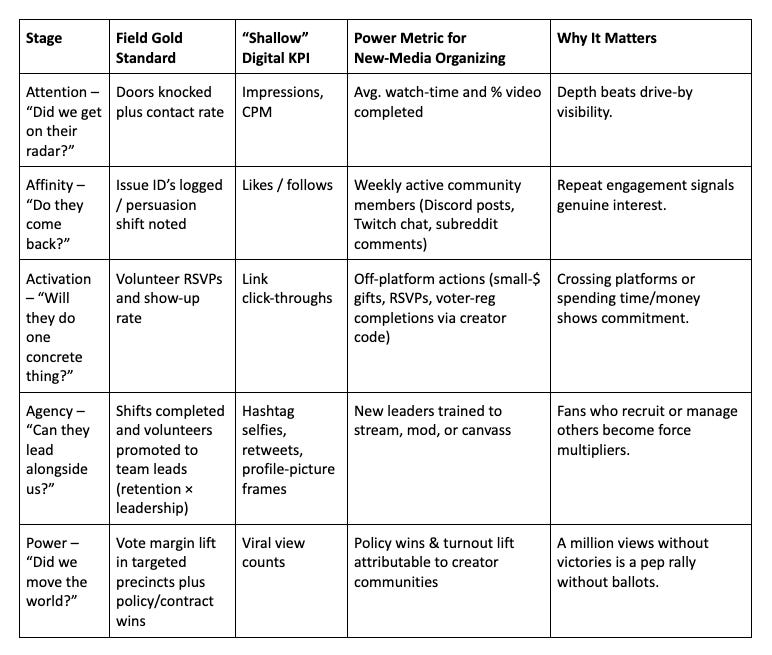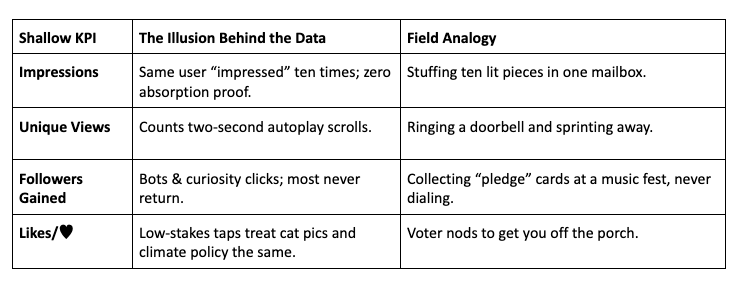Why the right’s “always-on” media machine wins, and how we catch up before 2026.
Ed. Note: A lot of progressives are assuming that Trump is so bad that we will inevitably win in the 2026 mid-terms. This article tells us that we can, but not the way we have been going about it.
By Dakota Hall
WE RENT BILLBOARDS; THEY OWN NETWORKS
In 2024 Donald Trump granted interviews to just nine male-leaning YouTube and podcast hosts. Those appearances pulled 113.6 million views, more eyeballs than Fox News drew on election night. Vice-President Harris followed a similar influencer route, yet the entire tour mustered only 6.8 million views. A 17-to-1 attention gap of that size is not a curiosity; it is a leading indicator of turnout. The numbers dramatize a structural problem: progressives approach digital politics as a media-buy, while the right treats it as nation-building.
That lopsided figure isn’t merely a vanity metric. YouTube watch‑time is one of the strongest predictors of political attention, sentiment shift, and, crucially, turnout among under‑35 voters, especially young men who are already drifting right in polling averages. When conservative creators monopolize the algorithm, they set the agenda every other platform amplifies, define the emotional frame in which policy debates land, and collect first‑party data on millions of persuadable viewers long before campaigns even open field offices. Meanwhile, progressive campaigns parachute in with six‑week paid buys that disappear when the invoice is spent. The result: an enthusiasm and narrative gap that converts directly into ballot‑box math. Elections aren’t lost the week before voting, they’re lost in the two‑year content runway leading up to it. Unless we build competitive creator networks now, the 2026 midterms will play out on terrain the right already owns.
THINK OF THE ECOSYSTEM AS FOUR INTERLOCKING RINGS:
A durable digital ecosystem behaves like an organism: each ring feeds the next, compounding reach, loyalty, and real-world power.
Ring 1 – Creators.
- What they are: podcasters, streamers, TikTok commentators, and meme pages with direct‑to‑audience distribution.
- Why they matter: they manufacture narrative velocity. A single high‑trust voice can convert passive scrollers into newsletter sign‑ups or strike fund donors in minutes.
- What the right does: funds multi‑year contracts so hosts can post daily without chasing ad spots.
- Progressive gap: we rent a creator’s time for a single paid post, then disappear, no relationship, no retargeting, no data.
Ring 2 – Communities.
- What they are: Discord servers, subreddits, Twitch chats, WhatsApp groups, regional meet‑ups, spaces where fans talk to each other, not just the host.
- Why they matter: two‑way forums build belonging and surface organizers, moderators, and hyper‑local storytellers.
- What the right does: Turning Point USA hosts steer supporters into branded Discords that run 24/7 and double as volunteer pools for rallies or canvas launches.
- Progressive gap: campaign Slack channels close after Election Day and have no on‑ramps for organic fan discussion.
Ring 3 – Infrastructure.
- What it is: physical studios, mobile clip‑editing farms, CRM‑fed data dashboards, compliance counsel, and union‑rate production crews.
- Why it matters: high‑volume, high‑quality content keeps algorithms happy and shields talent from burnout and de‑platforming threats.
- What the right does: Daily Wire’s Nashville complex pushes out 300+ clips per day, while its copyright team fast‑lanes takedowns and syndication deals.
- Progressive gap: creators cut footage in bedroom closets and wait weeks for legal clearance on a single ad.
Ring 4 – Capital.
- What it is: revenue‑share funds, low‑interest equipment loans, and three‑ to five‑year operating grants that cover salaries and gear depreciation.
- Why it matters: predictable cash lets teams plan multi‑cycle growth instead of living from ad-network payout to ad-network payout.
- What the right does: Angel investors seed production startups and stay onboard until cash‑flow positive, then reap subscription revenue.
- Progressive gap: one‑year foundation grants labeled “project‑specific” that vanish before a studio even breaks even.
Right-wing media already funds and synchronizes all four. Progressives mostly dabble in Ring 1 (one-off influencer partnerships) and Ring 4 (short-term ad buys) while Rings 2 & 3 remain skeletal. Closing that gap means building Rings 2 & 3 intentionally instead of hoping they materialize.
WHAT THE RIGHT GOT RIGHT, AND WHY IT WORKS
Long-form immersion creates identity. Two- and three-hour podcasts mingle policy riffs with personal stories, building a relationship with the audience: the one-sided but sticky sense that a host is a friend. Audience-analysis studies show time spent, not reach, predicts whether listeners later adopt a host’s political cues. A campaign’s 30-second pre-roll cannot compete.
Algorithmic rabbit holes automate persuasion. Once a viewer clicks on “border crisis” or “anti-woke comedy,” YouTube’s recommender graph serves hotter adjacent takes. Research presented in 2024 confirmed that extremist communities still rely on YouTube because playlist logic keeps viewers inside ideologically homogenous loops, no field organizer required.
Campus-to-content flywheels turn fans into foot soldiers. Turning Point USA claims chapters on more than 3,500 high-school and college campuses. Local activists clip rallies for TikTok, which recruits new students for in-person conferences such as AmericaFest. Each loop expands both the street operation and the online audience that regards TPUSA as the “cool kids” of politics.
Owning the assets locks in resilience. Outlets moved beyond YouTube ads to studios, national tours, and even a children’s streamer, Bentkey, so every revenue stream cycles back into talent, lawyers, and promotion. If an algorithm or advertiser turns hostile, they still hold the means of production.
Those four habits give the right persistent attention, automated growth, offline muscle, and financial self-reliance. Until progressives mirror that loop, weekly creator cohorts, technology that nudges viewers to action, campus hubs that feed an online/offline circuit, and cooperatively owned studios, we will keep paying billboard rates on a highway they already own.
FOUR FRONTIERS PROGRESSIVES MUST EXPLORE, WITHOUT APOLOGY
First, creator fellowships: year-round stipends and shared studios that free emerging hosts from brand-deal compromise. Quarterly disclosure should focus on watch-time and conversion to action, not canned talking points.
Second, organizing-architect bootcamps: embed persuasion-savvy organizers in districts like AZ-01 or MI-07, charged with translating a viral clip into canvass routes, strike support, or county-board testimony within seventy-two hours.
Third, micro-grant rapid-response funds: forty to fifty awards of $25-50k each cycle for experiments, e-sports-arena canvasses, voter-file Discord bots, IRL TikTok clinics. Publish the data; replicate what sticks.
Fourth, co-operative production infrastructure: low-interest movement loans for multicam studios in Milwaukee, Detroit, or Phoenix. Creators earn equity through usage; once the loan is repaid, the asset stays in movement hands, no landlord, no venture-capital exit.
These ideas are neither luxury nor gadget. They are the missing middle rings that make digital power compound instead of evaporate every November.
MEASURING POWER, NOT JUST REACH
Field organizers have spent decades refining what counts as progress: a conversation that yields an issue ID, a volunteer pledge, or a measurable bump in turnout. Those metrics, contacts, IDs, commitments, and the eventual vote margin, tell us whether power is actually shifting. Digital programs need the same clarity. Instead of celebrating “100,000 impressions,” we should be asking: How long did people stay? Did they return? How many took an action that built collective capacity, donating, joining a Discord working group, showing up for canvass launch? When our online metrics track the same arc from engagement to agency to concrete wins, we know we’re not just reaching people; we’re organizing them.
- Attention should be average watch-time and completion rate, the onscreen equivalent of a voter who kept the door open.
- Affinity is weekly active community members, Discord posts, Twitch chat lines, subreddit comments, not raw likes.
- Activation counts off-platform actions: small-dollar gifts, strike RSVPs, voter-registration completions traced through creator codes.
- Agency asks whether viewers become creators, moderators, or canvass captains, the digital precinct leaders.
- Power measures policy wins or turnout deltas in the zip codes where those creator communities concentrate.

WHY SHALLOW METRICS KEEP MISLEADING US

If we keep measuring digital success in the same way we count billboards, who glanced, who liked, who scrolled past, we will keep getting billboard-level results: fleeting awareness and zero lasting power. The right has already demonstrated what serious digital infrastructure looks like: creators who broadcast daily, communities that stay active around the clock, studios that never shut down, and revenue streams that underwrite the whole machine. Progressives can match that model, but only if we close the middle rings we’ve neglected and hold ourselves to field-grade metrics:
- Depth over reach: average watch-time, not raw impressions.
- Community over vanity: weekly active members, not follower spikes.
- Agency over clicks: new leaders trained, not hashtag selfies.
- Power over Viral Moments: turnout lifts and policy wins, not view counts.
The blueprint is straightforward; the discipline is the challenge. When we budget for studios instead of single-cycle ads, endow creators instead of one-off posts, and publish turnout deltas instead of impression tallies, we stop renting attention and start accumulating power. Everything else is just noise that fades when the feed refreshes.
Passport in one hand, controller in the other, Dakota Hall brings Black & Indigenous pride to sharp takes on politics, culture, gaming, and the Marvel Universe. A triple Cancer survivor with a love for nature, she is all about deep dives and big adventures.
This Substack article was published on May 9, 2025 at The Ground Game.
